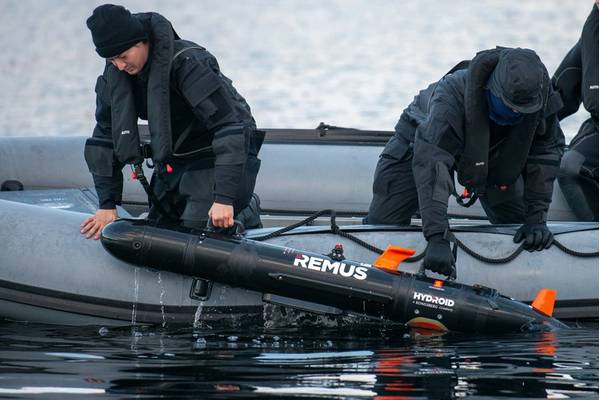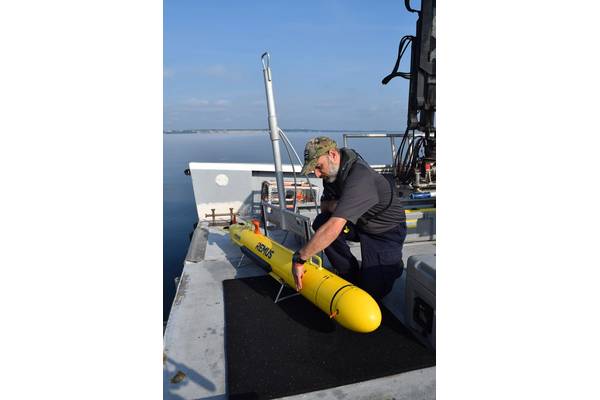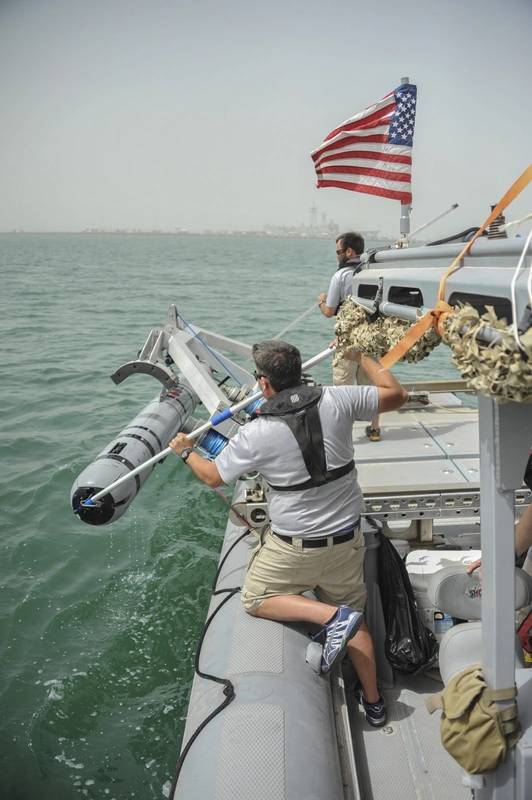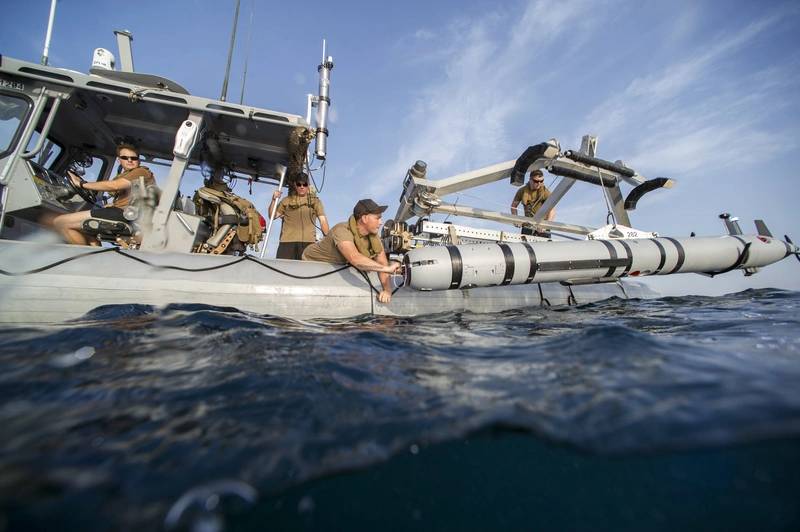



Hydroid, a familiar name in the Unmanned Underwater System defense market, was bought this year by Huntington Ingalls Industries (HII). We checked in with Duane Fotheringham, President, Unmanned Systems, HII, for insights on the path forward for autonomy in the defense sector.
Hydroid is a long-established, well-known name in the subsea Autonomous Underwater Vehicle (AUV) sector that recently had a change in corporate ownership, joining the Huntington Ingalls Industries family of companies. “The immediate impact is that we are now part of a much larger organization and have access to those resources,” said Fotheringham. “The Unmanned Systems business unit consists of the REMUS, Seaglider and Proteus product lines as well as support to Boeing on the Orca program, which broadens our portfolio and allows us to offer the full range of UUVs, from small class to extra large class.”
HII is not simply a larger corporate entity, but one with a treasure trove of experience serving the U.S. Navy with both surface craft and nuclear submarines. “We are also able to leverage HII’s expertise in submarine and ship design to provide increased capability in platform integration,” said Fotheringham.
With the move under the HII banner the Hydroid brand is transitioning into Huntington Ingalls Industries. According to Fotheringham, “the REMUS and Seaglider brands will remain product lines within the organization. We will also continue to advance REMUS as part of our partnership with the Woods Hole Oceanographic Institution (WHOI) through our technology transfer agreement.”
 Members of the Unmanned Underwater Vehicle detachment, Commander, Task Group (CTG) 56.1, guides a UUV for recovery during a training exercise. CTG 56.1 provides mine countermeasures, explosive ordnance disposal, salvage diving, force protection and promotes theater security cooperation efforts in the U.S. 5th Fleet area of responsibility. (U.S. Navy photo by Mass Communication Specialist 1st Class Peter Lewis/Released)
Members of the Unmanned Underwater Vehicle detachment, Commander, Task Group (CTG) 56.1, guides a UUV for recovery during a training exercise. CTG 56.1 provides mine countermeasures, explosive ordnance disposal, salvage diving, force protection and promotes theater security cooperation efforts in the U.S. 5th Fleet area of responsibility. (U.S. Navy photo by Mass Communication Specialist 1st Class Peter Lewis/Released)
Serving the Navy
While traditional subsea companies manufacture product primarily for three broad targets: military, offshore energy and science, the military clients come with a unique set of requirements. “With the U.S. Department of Defense focusing on Unmanned Maritime Autonomy Architecture (UMAA) and Modular Open Systems Architecture (MOSA), open architecture is vital to ensuring compatibility across systems, platforms and domains,” said Fotheringham. “Launch and recovery becomes a challenge when a UUV might be launched from a dock, a RHIB, a submarine or a vessel with a high freeboard. Our new-generation UUVs are all being designed with modularity and flexibility in mind to ensure compatibility across many different mission types.
Regardless of end customer, Fotheringham has guidance over an enviable family of UUV’s to meet the mission. “Our main product lines have always been the REMUS 100, REMUS 600 and REMUS 6000. However, the technology that goes into these systems is scalable,” said Fotheringham. “The REMUS Technology Platform includes advanced core electronics, open architecture, autonomy and modularity that can be scaled to everything from small-class to extra large-class UUVs. While physical parameters are designed to the specific requirements of a vehicle, the key to this technology is independent of hull diameter, size or depth rating.’
The Seaglider product was integrated into the portfolio last year. The M1, a 1,000 meter-rated buoyancy-driven glider, has been in development since 1995, and according to Fotheringham more than 150 have been sold worldwide. “We are also beginning to manufacture the Seaglider C2, a 200 meter-rated glider that can go from fresh to salt water without the need to reballast.”
As with any tech company in the sector, resting on past success is not an option. “Recently we delivered the REMUS 300, a small-class UUV, to the Defense Innovation Unit (DIU) for evaluation by the Naval Information Warfare Center,” said Fotheringham. “With advanced modularity that includes swappable payloads and battery sections, this UUV provides flexibility to maximize endurance and portability in easily changeable configurations.”
With the market for offshore energy production currently is disarray, military markets offer potential for suppliers of advanced unmanned systems. “Based on recent U.S. Navy requirements for the small and medium UUV RFPs, modularity and flexibility seem to be key. They have requested systems that can perform many different missions from different platforms,” said Fotheringham. “With an increasing focus on unmanned systems, I think we will continue to see the need for advanced autonomy. UUVs act as a force-multiplier, expanding the reach of our defense forces and helping them to complete missions more efficiently.” From left to right, Machinist Mate 1st Class Micah Patterson, Boatswains Mate 1st Class Stephen Wodraska, Mineman 1st Class Coy Tully and Mineman 3rd Class Pete Calvert, assigned to Commander, Task Group 56.1, launch a MK 18 MOD 2 unmanned underwater vehicle from a rigid-hull inflatable boat during Squadex 2016. Squadex 2016 demonstrates U.S./U.K. mine detection capabilities in the U.S. 5th Fleet area of operations. (U.S. Navy Combat Camera photo by Mass Communication Specialist 1st Class Blake Midnight)Challenges Ahead
From left to right, Machinist Mate 1st Class Micah Patterson, Boatswains Mate 1st Class Stephen Wodraska, Mineman 1st Class Coy Tully and Mineman 3rd Class Pete Calvert, assigned to Commander, Task Group 56.1, launch a MK 18 MOD 2 unmanned underwater vehicle from a rigid-hull inflatable boat during Squadex 2016. Squadex 2016 demonstrates U.S./U.K. mine detection capabilities in the U.S. 5th Fleet area of operations. (U.S. Navy Combat Camera photo by Mass Communication Specialist 1st Class Blake Midnight)Challenges Ahead
While technology has evolved rapidly in the subsea space, there remain challenges to work efficiently, effectively in what is arguably the harshest environment on the planet. “Our customers want to perform longer and more complex missions,” said Fotheringham. “The key to being able to accomplish this is autonomy and reliability. With UUVs the ability of an operator to interact with the vehicle is limited; therefore, the autonomy must be advanced enough to accomplish the mission and overcome unforeseen challenges and changing environmental conditions with no operator input. It also must be reliable enough to operate for long periods of time without failure.”
Advances in autonomy, artificial intelligence and machine learning will continue to push the boundaries of what is possible, according to Fotheringham. “By leveraging advanced GPUs to run machine learning algorithms, performing data fusion from sensors and maintaining greater situational awareness, vehicles will have the ability to adapt in real-time to their environment. Fielding these systems also requires new approaches to verification and validation to ensure their safety and reliability. Not only are we investing in these areas, but we have also focused on building an open architecture that supports insertion of new technologies and algorithms developed by us and other third parties.
Advances in autonomy, of course, require ample ability to invest. “As discussed, we invest heavily in advancing the modularity, reliability, open architecture and autonomy of the REMUS Technology Platform,” said Fotheringham. “We are also investing in ways to make the vehicles easier to use and maintain. On our latest REMUS 300 vehicle, we introduced field-swappable, environmentally sealed batteries in several sizes that allow the user to quickly get the vehicle back in water in a configuration that meets their mission profile. We have also maximized the use of common parts and assemblies throughout the REMUS Technology Platform, reducing logistics and total ownership costs for our customers.”
In addition, he said the company is constantly on the lookout for new options to shorten the cycle between data collection and putting the data to use. “Recently, we integrated an in-mission processor onto a REMUS 600 with high-resolution interferometric synthetic aperture sonar (HISAS). This processor compresses the imagery as it’s collected, reducing data offload times when the vehicle returns,” said Fotheringham. “This is ideal for time-sensitive missions like mine countermeasures, where faster data access means safer, more efficient operations.”
 REMUS 6000 HISAS. Photo: HII
REMUS 6000 HISAS. Photo: HII
Arguably the greatest challenge today, still, lies in the ability to find and deliver increasingly robust power supply. “We anticipate that improvements in safe, reliable, long-endurance energy systems over the next few years will have significant immediate impact on UUV capabilities,” said Fotheringham. “The physical endurance of a UUV is much greater than the energy systems that currently power them, so increasing the energy density on a vehicle pays immediate dividends. This supports the longer, more complex missions discussed previously. A vehicle designed from the bottom up to be modular and flexible, like the REMUS 300, can make use of any of these energy system improvements as they come online.”
There are many developments ongoing to bring new, safe battery chemistries, fuel cells and other hybrid energy systems to the UUV domain. “These can be integrated over time to increase the endurance of an existing vehicle through spiral upgrades, using our well-defined hardware and software interfaces,” said Fotheringham.
The Impact of COVID-19
No business is immune from the impacts of the recently COVID-19 pandemic, and Huntinington Ingalls Industries Unmanned Systems is no exception. “Massachusetts, the base of our Unmanned Systems business unit, is currently under regulations that require non-essential businesses to remain closed,” said Fotheringham. “The production of technology related to national defense is considered an essential activity, so we are continuing to manufacture all product lines with some modifications. Anyone who has the ability to work from home has been doing so since March. This limits potential exposure of our manufacturing and engineering personnel and allows employees to balance work with their family requirements. Personnel who can only work onsite also have the option to change to a more flexible schedule. We’ve instituted social distancing requirements at our facility to ensure employee safety, and we are doing everything we can to make sure our employees remain safe while continuing our responsibilities as an essential business.”
 REMUS 300. Photo: HII
REMUS 300. Photo: HII


